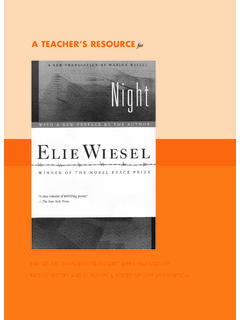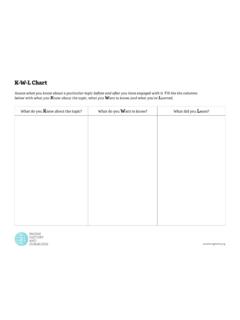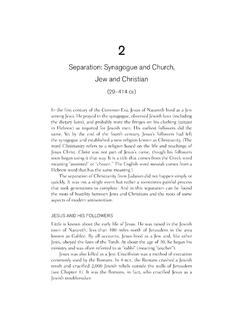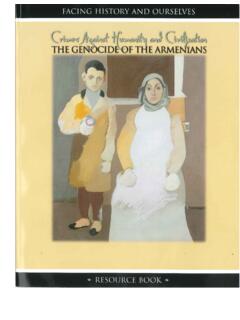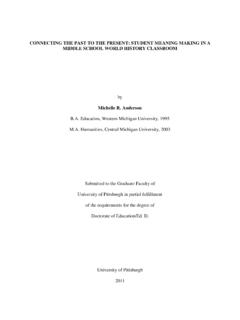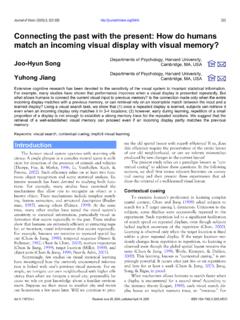Transcription of WRITING TEGIES - Facing History and Ourselves
1 WRITINGSTRATEGIEST able of ContentsCRAFTING A THESIS AND ORGANIZING IDEAS 4 STRATEGY 1. Taking a Stand on Controversial Issues: Speaking and Listening Strategies.. 5 STRATEGY 2. Building Arguments Through Mini-Debates.. 8 STRATEGY 3. Linking Claims and Evidence with Analysis .. 9 STRATEGY 4. Thesis Sorting ..11 STRATEGY 5. Tug for Truth ..13 STRATEGY 6. Refuting Counterarguments..14 PROVING YOUR POINT THROUGH LOGICAL REASONING IN BODY PARAGRAPHS 16 STRATEGY 7. Claims, Data, And Analysis..17 STRATEGY 8.
2 Using Exemplars (or Mentor Texts)..20 STRATEGY 9. Using Graphic Organizers to Organize WRITING ..21 STRATEGY 10. Sentence-Strip Paragraphs..26 FRAMING AND connecting IDEAS IN INTRODUCTIONS AND CONCLUSIONS 28 STRATEGY 11. Introductions: Inverted Pyramid ..29 STRATEGY 12. Conclusions: Text-To-Text, Text-To-Self, Text-To-World ..30 STRATEGY 13. Fishbowl ..31 REVISING AND EDITING TO IMPACT YOUR AUDIENCE 33 STRATEGY 14. 3-2-1 ..34 STRATEGY 15. Adding Transitions ..35 STRATEGY 16.
3 Backwards Outline ..36 STRATEGY 17. Conferring ..39 STRATEGY 18. Read-Alouds ..41 PUBLISHING/SHARING/REFLECTING 42 STRATEGY 19. Reflecting on the Process..43 STRATEGY 20. Online Publishing ..44 CRAFTING A THESIS AND ORGANIZING IDEASUse these strategies after the students have had an opportunity to engage with the evidence they might use to craft an argument in response to a WRITING prompt, they can begin to integrate, synthesize, and categorize their ideas. In this section, teachers can challenge students to sort out What is my perspective on this issue? Much of historical thinking and WRITING involves forming strong arguments or interpretations based on the core concepts in History : Why does this matter?
4 How did this happen? What motivated people in the past to think and act in the ways they did? How do we know what we know? How was this past situation similar to present -day situations? The prompts are designed to engage students in these big : We suggest students begin to craft a thesis after they have had many opportunities throughout a unit to examine and understand the evidence. A recent study found that college professors express concern that many students leap to WRITING a thesis before they have explored their ideas in sufficient Here, crafting a thesis and organizing ideas are paired, as a way to help students begin to integrate, synthesize, and categorize their Stevi Quate, ed.
5 , Lessons Learned: A Report of the DASSC WRITING Inquiry Project, June 1, 2011, 4 STRATEGY 1. Taking a Stand on Controversial Issues: Speaking and Listening StrategiesWRITING FOCUS: Students collect evidence to defend their argumentCOMMON CORE ALIGNMENT: Draw evidence from informational texts to support analysis, reflection, and research. ( )RATIONALES peaking and listening strategies give students early practice with explaining how evidence supports their position. These strategies also support students critical thinking, since students consider an issue from multiple perspectives. Engaging in speaking and listening can be an effective WRITING exercise before an essay assignment because it brings out arguments for or against a thesis.
6 It can also be effective after WRITING a first draft of an essay; often, a classroom discussion will clarify thinking and help a student locate the part of their argument to these strategies involve sharing opinions, often in a passionate way, set a contract before this activity. Reiterate your class rules about respect for the opinions and voices of others; call for them to be honest but not insulting. Readdress ways to constructively disagree with one another, and require that when offering their opinion or defense of their stance, they speak from the I, rather than from an accusatory You. A. BAROMETER PROCEDURE1. Preparation. Place Strongly Agree and Strongly Disagree signs at opposite ends of a continuum in your room.
7 Or you can post any statement and its opposite at two ends of a continuum. Any argument or thesis statement can be used for this activity. Give students a few minutes to respond to the prompt in WRITING before you ask them to take a stand. 2. Take a Stand. Ask students to stand on the spot of the line that represents their opinion, telling them that if they stand on either extreme they are absolute in their agreement or disagreement. They may also stand anywhere in between the two extremes, depending on how much they agree or disagree with the Explain Positions. Once students have lined up, ask them to explain why they have chosen to stand where they are.
8 Encourage students to refer to evidence and examples when defending their stance. If students are persuaded to change their opinion, ask them to move along the continuum to show their new SPAR (SPONTANEOUS ARGUMENTATION) PROCEDURE1. Preparation. Divide class in half. Assign one side to be the pro position and the other side to be the con position. Have students move their desks so they are sitting opposite an opponent. Write a debatable proposition on the Brainstorm Arguments. Give students one to two minutes to write down their arguments and evidence for or against the Opening Statements. The students will be SPAR ring with the person sitting across from them.
9 Each student (pro and con) presents a one-minute opening statement making his/her case while the other listens quietly and takes Discussion. Give students 30 seconds to prepare ideas for what they want to say to their opponent. Invite each side to engage in a three-minute discussion during which they may question their opponent s reasoning or examples or put forth new ones of their Closing Statements. Give students 30 seconds or one minute to prepare a closing statement. Each student presents a one-minute closing statement while the other listens quietly, and then the roles FINAL WORDThis strategy is a way for students to talk without having the competitiveness that can accompany debate in the Preparation.
10 Divide students into groups of four and have them position themselves so that they are in a Prompts. Create a list of claims for students to respond to or ask students to write their own claims (thesis statements).3. Sharing in Small Groups. Ask each group to choose someone to begin. The first few times that you do Final Word, remind students of the procedure before you officially begin. The first student has 30 seconds to respond to the claim or share his or her thesis statement. After 30 seconds, the person to the right of the first student has a chance to react to the thesis. This student can choose to respond to the first student or simply give his or her own information.


